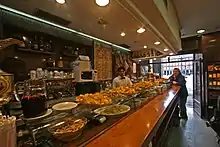Tapas
A tapa (Spanish pronunciation: [ˈtapa]) is an appetizer or snack in Spanish cuisine. Tapas may be cold (such as mixed olives and cheese) or hot (such as chopitos, which are battered, fried baby squid, or patatas bravas). In some bars and restaurants in Spain and across the globe, tapas have evolved into a more sophisticated cuisine. Tapas can be combined to make a full meal. In some Central American countries, such snacks are known as bocas. In parts of Mexico, similar dishes are called botanas.
 Tapas in Barcelona | |
| Course | Appetizer or snack |
|---|---|
| Place of origin | Spain |
| Serving temperature | Hot or cold |
| Main ingredients | Various |
History

The word "tapas" is derived from the Spanish verb tapar, "to cover", a cognate of the English top.[1]
In pre-19th-century Spain tapas were served by posadas, albergues or bodegas, offering meals and rooms for travellers. Since few innkeepers could write and few travellers read, inns offered their guests a sample of the dishes available, on a "tapa" (the word for pot cover in Spanish).[2]
According to Joy of Cooking, the original tapas were thin slices of bread or meat which sherry drinkers in Andalusian taverns used to cover their glasses between sips.[3] This was a practical measure meant to prevent fruit flies from hovering over the sweet sherry (see below for more explanations). The meat used to cover the sherry was normally ham or chorizo, which are both very salty and activate thirst. Because of this, bartenders and restaurant owners created a variety of snacks to serve with sherry, thus increasing their alcohol sales.[4] The tapas eventually became as important as the sherry.
Tapas have evolved through Spanish history by incorporating new ingredients and influences. Most of the Iberian Peninsula was invaded by the Romans, who introduced more extensive cultivation of the olive following their invasion of Spain in 212 B.C.[5] and irrigation methods. The discovery of the New World brought the introduction of tomatoes, sweet and chili peppers, maize (corn), and potatoes, which were readily accepted and easily grown in Spain's microclimates.
There are many tapas competitions throughout Spain, but there is only one National Tapas competition,[6] which is celebrated every year in November. Since 2008, the City of Valladolid and the International School of Culinary Arts[7] have celebrated the International Tapas Competition for Culinary Schools.[8] Various schools from around the world come to Spain annually to compete for the best tapa concept.
Origin
Though the primary meaning of tapa is cover or lid, in Spain it has also become a term for this style of food. The origin of this new meaning is uncertain but there are several theories:
- The tapas tradition may have begun when king Alfonso X of Castile recovered from an illness by drinking wine with small dishes between meals. After regaining his health, the king ordered that taverns would not be allowed to serve wine to customers unless it was accompanied by a small snack or "tapa".[9]
- Another popular explanation says that King Alfonso XIII stopped by a famous tavern in Cádiz (Andalusian city) where he ordered a cup of wine. The waiter covered the glass with a slice of cured ham before offering it to the king, to protect the wine from the beach sand, as Cádiz is a windy place. The king, after drinking the wine and eating the tapa, ordered another wine "with the cover".[10]
See also
- List of tapas
- List of hors d'oeuvre
- Aahaan kap klaem
- Antipasto
- Crostino
- Hors d'œuvre
- Meze
- Pincho
- Pu pu platter
- Smörgåsbord
- Smørrebrød
- Zakuski
References
- "Tapas, the Little Dishes of Spain". Living Language. 20 March 2012. Archived from the original on 3 May 2018. Retrieved 2018-05-02.
- Plunkett-Hodge, Kay (1 July 2016). "The history of the Spanish tapas". The Telegraph. ISSN 0307-1235. Archived from the original on 4 November 2018. Retrieved 2018-05-02.
- Rombauer, Irma S., 1877-1962. (2006). Joy of cooking. Becker, Marion Rombauer., Becker, Ethan, 1945-. New York: Scribner. ISBN 0743246268. OCLC 71800771.
{{cite book}}: CS1 maint: multiple names: authors list (link) - Casas, Penelope (2007). "Introduction". Tapas : the little dishes of Spain (Rev. & updated ed.). New York: Alfred A. Knopf. pp. xv. ISBN 978-0-307-26552-4. OCLC 70176935.
- "History of Olive and Olive Oil". Spanish Food. Archived from the original on 2018-02-01. Retrieved 2018-01-16.
- "Concurso nacional e internacional de pinchos y tapas ciudad de Velladolid" [National and international contest of skewers and tapas city of Velladolid] (in Spanish). Archived from the original on 17 May 2014. Retrieved 2019-01-02.
{{cite web}}: CS1 maint: unfit URL (link) - "International School of Culinary Arts". International School of Culinary Arts. Archived from the original on 6 November 2017.
- "4th International Culinary Schools Tapas Competition 2012". Escuela Internacional de Cocina. 25 July 2012. Archived from the original on 2012-07-31. Retrieved 2012-08-09.
- Fadón, Y.V. (1999). "The History of Tapas". El mudo de las Tapas, The World of Tapas in Spain. Translated by Madeleine Lewis, 2005. Archived from the original on 2012-06-22. Retrieved 2012-06-24.
- "El origen de las Tapas y Alfonso XIII" [The origin of the Tapas and Alfonso XIII]. ErroresHistoricos.com (in Spanish). Archived from the original on 2010-11-22. Retrieved 2011-01-17.
External links
- About.com Guide to Tapas in Spain.
- El mundo de las Tapas. History and recipes in Spanish and English
- Tapa Tells All